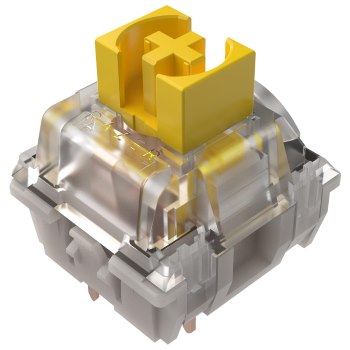Choosing a mechanical keyboard can be daunting, especially for first-time buyers. The switch type is the most crucial factor to consider when selecting a keyboard, as it directly impacts how the keys feel and sound during use. Mechanical keyboard switches are divided into three primary categories: Clicky, Tactile, and Linear.
Each has distinct characteristics that make them more suitable for different tasks, from typing to gaming. In this guide, we’ll dive deep into the technical aspects of these switches, covering how they work, what they’re best suited for, and how you can make an informed decision.
What is a Mechanical Switch?
A mechanical switch is a physical mechanism under each keycap in a mechanical keyboard that uses a spring and metal contacts to register a keypress. Unlike membrane or rubber dome keyboards, which rely on a pressure pad, mechanical switches provide a more precise and customizable typing experience. Mechanical switches are praised for their durability, often rated for 50 to 100 million keystrokes compared to 5 to 10 million for membrane keyboards.
Each mechanical switch is designed with a few key attributes:
- Actuation Force: The amount of force (measured in grams or centinewtons) required to press the key until it registers a keystroke.
- Travel Distance: The distance a key moves from its resting position to the point of actuation.
- Actuation Point: The point at which the switch sends a signal to the computer that a key has been pressed.
- Reset Point: The point where the switch resets and is ready to register another keypress.
- Hysteresis: The difference between the actuation point and the reset point. Lower hysteresis is usually better for gaming, as it allows for quicker repeated keystrokes.
Let’s explore the three main switch types in more detail.
Clicky Switches
Clicky switches are known for their signature sound and tactile feedback, making them one of the most popular choices for typists. The defining feature of a clicky switch is a click bar or click jacket that produces a distinct, audible click when the key is actuated. This click sound occurs when the slider moves past a threshold within the switch, causing a sharp sound.
How Do Clicky Switches Work?
In clicky switches like the Cherry MX Blue or Kailh Box White, the click mechanism is built into the switch stem. As you press the key, the stem moves down, compressing the spring. At the actuation point, the click mechanism snaps into place, creating both the tactile bump and the audible click. The tactile bump occurs slightly before the actuation point, allowing users to feel the key actuating without bottoming out.
Actuation Characteristics:
- Actuation Force: Typically between 50g to 70g.
- Total Travel Distance: Around 4.0mm.
- Actuation Point: Usually 2.0mm.
- Audible Feedback: Loud, distinct click.
Best Use Cases for Clicky Switches:
 Clicky switches are excellent for typing-heavy workloads, where precise feedback helps improve accuracy and speed. The tactile bump and click sound provide clear feedback that the key has been pressed, which is why many typists prefer these switches. They are also favored by users who enjoy the “retro” feel of classic typewriters.
Clicky switches are excellent for typing-heavy workloads, where precise feedback helps improve accuracy and speed. The tactile bump and click sound provide clear feedback that the key has been pressed, which is why many typists prefer these switches. They are also favored by users who enjoy the “retro” feel of classic typewriters.
However, for environments that require quiet operation—like shared offices—clicky switches may not be the best option due to their noise level. Additionally, their hysteresis makes them less ideal for fast-paced gaming, where rapid key presses are needed.
Example of Clicky Switches:
- Cherry MX Blue: The most well-known clicky switch, offering 50g actuation force and 4.0mm total travel.
- Kailh Box White: Known for its durability and tight click, with a slightly lighter 45g actuation force.
- Razer Green: A proprietary switch similar to Cherry MX Blue, popular in Razer keyboards.
Tactile Switches
Tactile switches are quieter than clicky switches but still offer a noticeable bump at the actuation point. They provide physical feedback when a keystroke is registered, without the loud click sound. This makes tactile switches a versatile option that balances typing and gaming functionality.
How Do Tactile Switches Work?
Tactile switches work similarly to clicky switches, but they lack the mechanism that produces the clicking sound. Instead, they rely on the tactile bump created by the shape of the switch stem or a built-in protrusion inside the switch housing. As you press the key, the bump provides a noticeable increase in resistance, signaling that the key has been actuated without requiring the key to bottom out.
Actuation Characteristics:
- Actuation Force: Typically between 45g to 60g.
- Total Travel Distance: Around 4.0mm.
- Actuation Point: Around 2.0mm.
- Audible Feedback: Minimal to none; virtually silent.
Best Use Cases for Tactile Switches:
 Tactile switches strike a balance between typing and gaming. They’re quieter than clicky switches, making them more suitable for offices or shared spaces. The tactile bump provides feedback during typing, helping users to avoid bottoming out, which can reduce fatigue over long sessions.
Tactile switches strike a balance between typing and gaming. They’re quieter than clicky switches, making them more suitable for offices or shared spaces. The tactile bump provides feedback during typing, helping users to avoid bottoming out, which can reduce fatigue over long sessions.
For gaming, tactile switches are generally good for MMOs or games requiring frequent communication, as they offer tactile feedback without creating much noise, especially in voice chat scenarios. They are less likely to cause errors during typing, thanks to the tactile feedback.
Example of Tactile Switches:
- Cherry MX Brown: The go-to tactile switch, with a 55g actuation force and 4.0mm total travel.
- Zealios V2: A premium tactile switch, offering smoother keystrokes and a more pronounced bump.
- Gateron Brown: A lighter tactile option, often praised for its smoothness compared to Cherry MX Browns.
Linear Switches
Linear switches are the simplest in design, offering no tactile bump or audible feedback. These switches provide a smooth and consistent keystroke, making them ideal for gamers who need to press keys quickly and repeatedly without any interference. Linear switches are especially popular for fast-paced and competitive gaming where rapid key presses and precise input are crucial.
How Do Linear Switches Work?
Linear switches consist of a stem and spring that travel in a straight path, with no tactile event or click. When the key is pressed, the stem moves downward until the switch actuates at the actuation point, allowing for faster input since there’s no bump or resistance to slow the keypress. This smoothness is highly sought after in gaming keyboards, where speed and responsiveness are key.
Actuation Characteristics:
- Actuation Force: Typically between 30g to 60g.
- Total Travel Distance: Around 4.0mm.
- Actuation Point: Usually 1.8mm to 2.0mm.
- Audible Feedback: None, though bottoming out may cause noise.
Best Use Cases for Linear Switches:
 Linear switches are favored by gamers, particularly those who play FPS or MOBA games where rapid and repeated keypresses are essential. The smooth actuation allows for faster key input, and the lack of hysteresis is ideal for quick reset times. While great for gaming, linear switches might not be the best for heavy typing, as the absence of feedback can result in more typing errors, especially for those who aren’t used to the linear feel.
Linear switches are favored by gamers, particularly those who play FPS or MOBA games where rapid and repeated keypresses are essential. The smooth actuation allows for faster key input, and the lack of hysteresis is ideal for quick reset times. While great for gaming, linear switches might not be the best for heavy typing, as the absence of feedback can result in more typing errors, especially for those who aren’t used to the linear feel.
For users who want a quiet keyboard, linear switches are a good choice since they produce no sound on actuation. However, noise from bottoming out can still occur but can be mitigated with O-rings or other dampeners.
Example of Linear Switches:
- Cherry MX Red: A light, fast switch with 45g actuation force, popular among gamers.
- Gateron Red: Known for its smoother feel compared to Cherry MX Reds.
- Razer Yellow: A proprietary linear switch optimized for fast keypresses, found in Razer gaming keyboards.
Hot-Swappable Keyboards: Try Before You Commit
For those who are unsure which switch is best, investing in a hot-swappable mechanical keyboard is a great option. Hot-swap keyboards allow users to easily remove and replace switches without soldering. This means you can try different switch types and customize your keyboard to your exact preference.
 Switch tester kit with O-rings and keycap puller tool.
Switch tester kit with O-rings and keycap puller tool.
Additionally, switch testers can help users try out different switch types without committing to a full keyboard. These testers are small boards with several different switch types installed, allowing you to feel the difference before making a purchase.
Conclusion
Choosing the right switch type comes down to personal preference, and understanding the key differences between Clicky, Tactile, and Linear switches can help guide your decision. Whether you prioritize a satisfying typing experience, fast gaming response, or a balance of both, mechanical keyboard switches offer an unmatched level of customization and precision.
By trying different switches or investing in a hot-swappable keyboard, you can create the perfect setup for your needs—whether it’s for gaming, coding, or writing the next great novel.












Good Info, and i really was looking for something like this.
This is very easily understood by layman like me.
Thanks a lot.
Cheers!!
So for the most silent solution a linear switch with O rings would be the best choice.
The O rings help reduce the noise from bottoming out.
This was a very well-written intro to the different key switch types out there…thanks for alleviating my first world dilemma lolol. Seriously though, this did help.
This really helped me thx
So a linear keyboard is best for gaming? I bought a Havit mechanical keyboard that was heavily marketed as a gaming keyboard, but it was only available with clicky switches. I do like the keyboard. It feels and sounds very nice to type on, but I mostly game. Would linear have been a better choice in that case?
@Beavis I think that would depend on your preference and environment. If you (1) are in a work environment, (2)have roomate(s)/other people in the house/flat that does not like the clicking sounds, or (3)are annoyed by the sound and/or tactile feedback of the clicky switch, then the linears (if not other clicky switches) would have been better. But if none of the three conditions above is true, then that should be fine.
Yes and no, if you have been playing for a while and you feel ok, then you went with the right choice…
They talk about linears being better because in games like League of legends you have to repeatedly type the same key over and over and, with the clicky switches, in the way up after bottoming out there is some difference in the point the switch becomes actually deactived and the point where actually hear the “click”(hysteresis)
As a result, it makes it a bit more imprecise at really high speeds. But mind my words, if you are not a world champion with world champion fingers and reflexes you will be just fine and possibly enjoy the clickiness more than a linear switch…especially if you type a lot…
This is helpful. Thank you!
So I like playing games and I have lots of work, so should I get Linear or Tacticle.
Tactile for sure… very few people will have a good experience with linears for general purpose…
The fact that they are more prefered for gaming is simply because very serious gamers prefer them… but honestly it will not make you play better…and you might miss a good experience by not having the tactile feel when typing a lot for your work…
I found myself frequently activating keys accidentally with linear switches. At the end of the day, Cherry MX Browns were the “just right” for me. I prefer the tactile feel of those over the linear Reds. They have the same operating force, actuation points, and travel distances but just give me better feedback, overall. The linear switches don’t make me a better player, they make me worse!
This! Linear is really bad for (especially) competitive fps games like csgo (etc). I found my aim performance becoming worse with the linears (less consistency, more misses in flick shots, etc) than with tactile. I really don’t understand the marketing over linears. The lack of the bump makes it feedback less, meaning you don’t the certainty feeling that you’ve activate the key. Causes issues at the subconscious/autonomic level when playing.